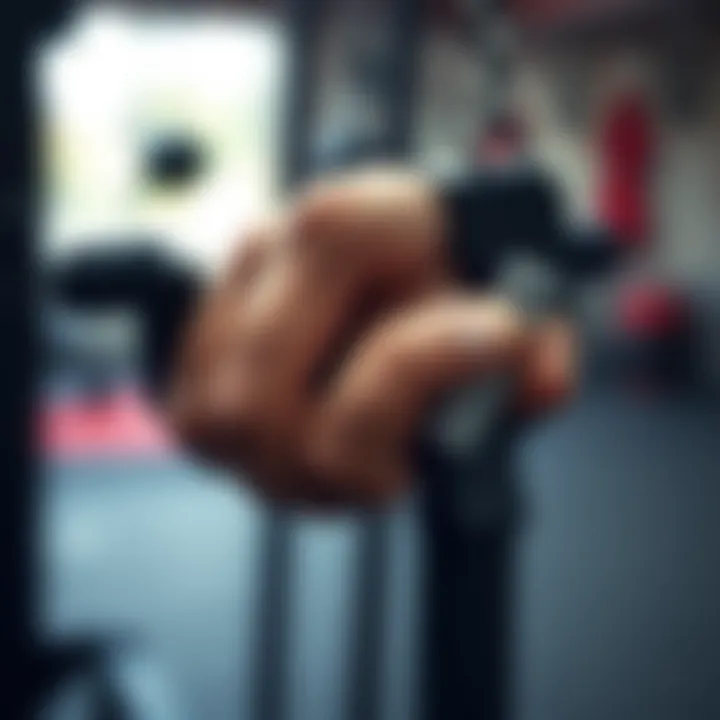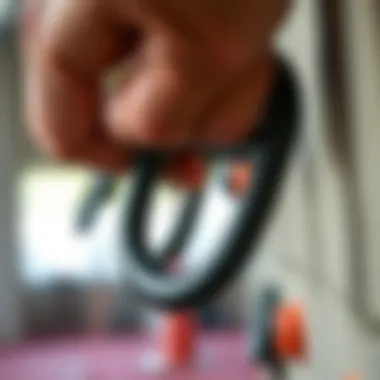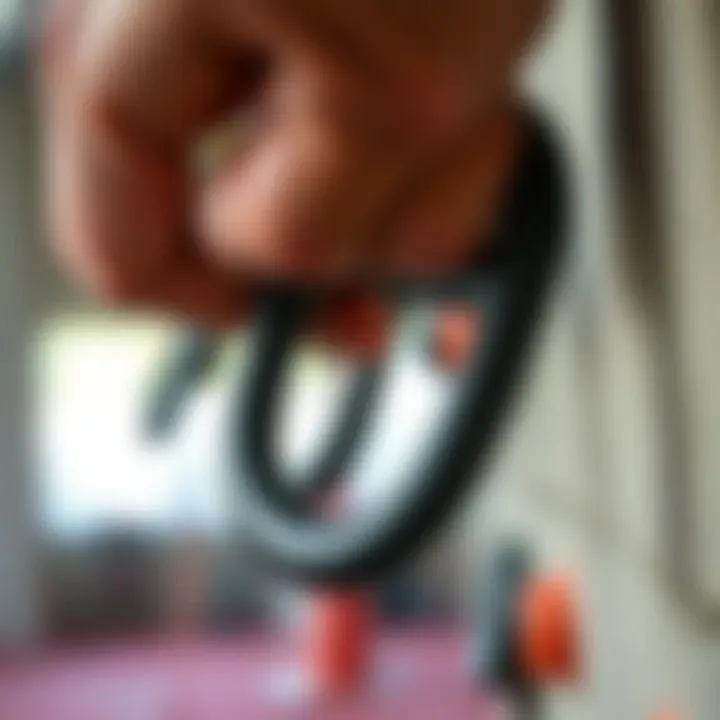Hand Strengtheners for Climbing: An In-Depth Guide


Intro
Climbing is as much about the mind as it is about the body. Yet, at the heart of every successful ascent is a gripping reality—hand strength. This integral component often gets shoved aside in the broader discussion of fitness, overshadowed by major muscle groups. Yet, climbers know that without a hold on their grip, they may as well be scaling a wall of jelly. Hand strength doesn’t merely contribute to a better chance of making it to the top; it can mean the difference between an exhilarating thrill and a dizzying fall.
In this guide, we venture beyond the mere recommendation of products, diving into the mechanics of grip strength essential for climbing. We will explore numerous types of hand strengtheners tailored for climbers, equipping you with tools and techniques designed to enhance performance on various surfaces—be it bouldering or sport climbing.
Understanding how your hands function and adapt under strain gives you a clearer direction in selecting the right approach for your training. Coupled with an exploration of injury prevention and the synergy between different training techniques, this guide aims to furnish you with the knowledge to ascend with confidence and precision.
Let’s kick things off by taking a closer look at the specific interests that draw climbers into the world of grip strength.
Understanding Grip Strength
Grip strength is a crucial factor in climbing, influencing not only performance but also the overall experience of the sport. Climbers rely heavily on their hands for both stability and power when navigating challenging routes. Without adequate grip strength, a climber may find themselves struggling to hold onto holds or execute complex movements, dampening their confidence and enjoyment.
Improving grip strength involves a multifaceted approach that transcends simple workouts. It’s about understanding the dynamics of how your hands engage with various climbing holds, ensuring the proper techniques are employed to leverage strength without risking injury. A well-rounded approach leads to enhanced muscle coordination, increased endurance, and improved overall climbing efficiency.
In this section, we explore what grip strength means in a climbing context. The next subsections break down the specific roles that grip strength plays, the types of grip strength climbers face, and methods to quantify it.
The Role of Grip Strength in Climbing
Grip strength is often described as the backbone of climbing. From technical routes that require delicate fingertip placements to steep overhangs demanding raw power, the ability to grip securely impacts success on every climb. Stronger grips not only help with maintaining hold but also enable climbers to dawdle on challenging holds for extended periods, which can be the difference between a successful ascent and a frustrating fall.
Moreover, effective grip strength can help distribute weight more evenly across the body, allowing climbers to conserve energy for longer climbs. This is vital for endurance-focused climbs where strategy and stamina come into play, proving that grip strength is not just about raw power but also about smart climbing.
Different Types of Grip Strength
There are three main types of grip strength that climbers need to be familiar with: Crimp Grip, Open Hand Grip, and Pinch Grip. Each one serves a unique purpose and is vital for specific climbing scenarios.
Crimp Grip
The crimp grip is a common yet powerful technique where climbers use their fingers to create a tight grip on small holds. This grip involves flexing the fingers at the second joint while pressing down with the fingertips. The primary characteristic that sets the crimp apart is its ability to generate significant force on tiny footholds, making it essential for high-level climbing.
However, while the crimp grip is often seen as advantageous due to its strength, it can also be a double-edged sword. Using it excessively can lead to injuries, especially in the tendons or ligaments of the fingers. Thus, while it's a preferred choice for many climbers tackling steep routes, it's crucial to balance its use with attention to overall hand health.
Open Hand Grip
In contrast, the open hand grip encourages a more relaxed hold where the fingers are spread and engaged with larger holds. This grip is essential for endurance climbs or when utilizing slopers—holds that lack positive edges. The key feature of the open hand grip is its potential to reduce strain on the fingers, allowing climbers to maintain a good grip without overworking their tendons.
While some may find themselves gravitating towards crimp grips for their strength, the open hand grip serves as a beneficial alternative that can lead to fewer injuries in the long run. Climbers who master this grip often find a better balance in their climbing performance.
Pinch Grip
The pinch grip comes into play when holds require squeezing with the thumb and fingers. This grip is characterized by how it engages both the thumb and the opposing fingers, requiring a unique strength that can make or break a climb. Pinching is particularly beneficial on wider holds, such as Hercules or sloper-type grips found on some bouldering routes.
Mastering the pinch grip enhances finger and thumb dexterity, but like the others, it has its drawbacks. Climbers can unintentionally overlook the importance of balancing grip training across all types, focusing too heavily on one may leave weaknesses in another. Therefore, incorporating pinch grip workouts into training regimens can provide crucial well-rounded development.
Measuring Grip Strength
Taking stock of grip strength is vital for climbers interested in tracking progress and honing their abilities. Several tools and methods can gauge grip strength, from handheld dynamometers to more complex testing configurations found in rehabilitation centers. These metrics can provide clarity on improvements over time and help climbers identify areas needing enhancement.
Types of Hand Strengtheners
When it comes to climbing, the strength of your hands can be a game changer. Gripping holds, pulling yourself up, and maintaining control while ascending all depend on good hand strength. Different types of hand strengtheners exist, and each has unique attributes that can benefit your climbing. Understanding their characteristics—not just superficially but on a deeper level—can help climbers make informed decisions on how to improve their grip performance.
Grip Trainers
Grip trainers are specialized tools designed to enhance your grip strength through various resistance levels. Imagine squeezing a device that gives as much resistance as a tough rock face. They often include adjustable settings to cater to different strength levels, which means they grow with you and your evolving abilities.
For instance, a popular option is the Captains of Crush Grippers, which come in various resistance levels. By regularly using them, you can effectively train different muscle fibers in your hands and forearms—this leads to improved grip strength.


Finger Weights
Finger weights are like little boosters strapped directly to your fingers. These weights can be simple, thinking of a mini dumbbell designed just for digits. By adding load to your fingers during specific exercises or stretches, you mimic the stress your hands encounter while climbing.
For example, when performing finger curls with weights, climbers can increase the difficulty of their workouts. This method ensures that your finger’s intrinsic muscles are working extra hard. However, caution is key; improper use may lead to strain, so it’s crucial to start light and gradually increase as your strength improves.
Stress Balls
Often viewed as simple tools for stress relief, stress balls pack a punch in the grip-strengthening realm too. While squeezing one might casually reduce your stress, doing so regularly can reinforce the strength of your grip. These handy balls come in various resistance levels and sizes, making them versatile. You can find ones that require a decent amount of effort to squish—ideal for building grip power over time.
For climbers, incorporating stress balls into warm-ups can help activate the necessary muscles before hitting the walls.
Resistance Bands
Resistance bands are like the Swiss Army knives of hand strengtheners. They are pliable, easy to store, and versatile. Bands allow for various movements that engage the hands, wrists, and fingers in unique ways. For hand exercises, you can simply loop a band around your fingers, creating tension that builds up strength through eccentric movements.
Moreover, these bands can facilitate exercises focusing on hand-opening, which helps prevent overuse injuries by taking your grip through a full range of motion. Throughout your training sessions, they can be integrated seamlessly, making them an effective tool for climbers looking to enhance grip stability while reducing injury risk.
In summary: Using these hand strengtheners not only boosts your grip but contributes to overall climbing performance—ensuring you stay ahead of the game!
Ultimately, selecting the right tool depends on personal preferences and climbing goals. Whether you choose grip trainers, finger weights, stress balls, or resistance bands, integrating them into your regular training routine can provide substantial benefits that translate into better climbing outcomes.
Benefits of Hand Strengtheners for Climbers
The importance of hand strengtheners in the climbing world cannot be overstated. Climbers of all levels, from novices to seasoned pros, can significantly enhance their capabilities by focusing on their grip strength. This section will delve into the myriad benefits of hand strengtheners, highlighting how they contribute to overall climbing performance, prevention of injuries, and increased endurance.
Improved Climbing Performance
When it comes to climbing, effective grip strength is like throwing oil on the gears of a machine—it just makes everything run smoother. Strong hands enable climbers to hold onto various holds with a firmer grip, allowing for more dynamic movements. This translates into confidence on the rock face, where each hold matters. For instance, if you can maintain a solid crimp grip during a challenging section, you will find yourself less fatigued and more capable of maintaining upward momentum.
Additionally, incorporating hand strengtheners into your routine enables you to tackle a broader spectrum of climbing routes. The added strength helps when transitioning between techniques, say from a pinch grip to an open hand grip, allowing for fluid movements even on tricky climbs.
Furthermore, the enhanced grip translates into improved overall control, offering a climber the ability to focus on technique and body positioning rather than worrying about slipping off holds. This focus frees the mind to strategize the next moves and assess the climbing line more effectively.
Injury Prevention
Injuries are all too common in the climbing community, often stemming from overexertion or lack of preparation. One of the primary advantages of dedicated hand-strengthening workouts is the increased resilience of tendons and ligaments surrounding the fingers and wrists. When a climber strengthens their grip, they not only develop muscle but also fortify these connective tissues, which are crucial for preventing injuries such as tendonitis.
Moreover, a well-structured hand strength regimen can improve the overall balance between muscle groups in the hand and forearm. This balance helps prevent overuse injuries that occur when certain muscles are disproportionately stronger than others. For instance, often climbers neglect the opposing muscle groups—strengthening the extensor muscles alongside the flexor muscles can further mitigate injury risks.
"When grip strength improves, so does resilience, paving the way for safer climbing experiences."
Enhanced Endurance
Climbing is no longer just about strength; endurance plays a vital role as well. By incorporating hand strengtheners, climbers can build muscular endurance. This means being able to maintain grip strength over longer periods, especially during prolonged climbs or difficult crux sections.
Developing endurance in the hands and fingers allows climbers to hold onto grips longer, reducing fatigue during technical sections. In practical terms, a climber with better endurance can attempt more challenging climbs or attempt each route multiple times, increasing their chances of success and improving overall climbing skills over time.
Ultimately, the benefits of hand strengtheners weave together to create a stronger, injury-resistant, and more capable climber. Each benefit compounds, making the climber not just better at their craft but also safer when pushing their limits. By understanding these advantages, climbers can make smarter choices about integration techniques in their training routines.
How to Incorporate Hand Strengtheners into Training
Integrating hand strengtheners into your climbing training routine is essential for anyone serious about improving their grip and overall climbing performance. Developing a practical and effective approach ensures you make the most of your training time while minimizing the risk of injuries. When considering how to incorporate these tools, it’s crucial to focus on your individual needs, skill level, and climbing goals. Effective hand training can enhance your capacity to tackle difficult routes and maintain better endurance over longer climbs.
Developing a Training Plan
Creating a tailored training plan is the foundation of incorporating hand strengtheners into your routine. First, evaluate your current grip strength and identify the specific areas that require improvement. For instance, do you struggle with pinch grips or crimp grips? Understanding your weaknesses will inform your training strategies.
Start by setting achievable goals. Perhaps you aim to increase your grip strength by a certain percentage over a defined period, like eight weeks. Your plans should include:


- Type of Exercises: Include a mix of grip trainers, finger weights, and resistance bands.
- Weekly Schedule: Designate specific days for hand strength workouts, perhaps two to three times per week.
- Progress Tracking: Keep a log of your advancements in strength and endurance levels. This helps with acknowledging growth or recognition of plateaus.
Frequency and Duration
Consistency is key when it comes to building grip strength. Generally, aim for two to four sessions each week, depending on your overall training intensity and schedule. Each session should last around 20 to 30 minutes, dedicating time to warm-up and cool-down exercises for recovery.
Ensure that each workout is formatted to keep the sessions engaging. A sample session could look like:
- Warm-up: Light stretching of fingers and wrists for 5 minutes.
- Specific Exercises: 15-20 minutes of various hand strengtheners.
- Cool down: Gentle stretches and relaxation of the hands and forearms for 5 minutes.
Make a habit of listening to your body. If you experience soreness or fatigue, adjust the frequency to allow for ample recovery time. Quality over quantity is vital.
Combining with Other Exercises
To optimize your hand strength training, consider integrating it with other physical exercises. Coupling hand-specific strength workouts with full-body routines can provide a comprehensive training experience. Here are a few examples of effective combinations:
- Core Workouts: Engaging your core while using hand strengtheners enhances your stability and overall performance.
- Finger Exercises with Climbing Drills: Using hand strengtheners while practicing climbing drills can simulate real climbing conditions.
- Strength Training: Pairing endurance-focused grip training with general strength training (like deadlifts or pull-ups) can ensure you maintain balance across muscle groups.
Remember, not all training has to be serious; mix in fun activities like climbing games to maintain engagement. This multi-faceted approach can help improve not just your hand strength, but also your climbing agility and overall fitness.
"Focus on gradual improvement, and let your training be as dynamic as your climbing."
In summary, incorporating hand strengtheners into your training regime doesn’t need to be overly complex. By developing a thoughtful plan, adjusting frequency and duration to match your lifestyle, and blending your workouts strategically, you can make significant strides in your climbing capabilities.
Common Mistakes to Avoid
Understanding the common blunders surrounding hand strength training is essential, especially for climbers striving to improve performance and avoid injuries. Averting these pitfalls can help ensure more effective workouts, leading to tangible gains in grip strength. Here, we delve into three notable mistakes that can undermine efforts: overtraining, neglecting other muscle groups, and ignoring pain signals.
Overtraining
Overtraining is a sneaky foe. Climbers often push themselves to their limits, thinking that more is always better. The truth is, your hands are part of a wider system that requires rest and recovery. Hitting the gym multiple times a week without adequate recovery can lead to diminished strength, increased fatigue, and even injury.
To avoid overtraining, schedule specific days for rest, allowing muscles and connective tissues the time they need to repair and grow. A good rule of thumb is to alternate gripping exercises with lighter strength workouts or completely different muscle groups on alternating days, giving your hands a breather.
"Rest is just as crucial as the workouts. Listen to your body for a stronger comeback."
Neglecting Other Muscle Groups
Focusing solely on hand strength might be like painting a vibrant picture but neglecting the canvas. Climbers need well-rounded strength, and this means training other muscle groups too, such as forearms, shoulders, and core. If you ignore these areas, your grip might become strong while the rest of your body struggles, leading to poor climbing performance.
Incorporating full-body strength exercises will create functional power. Consider exercises like pull-ups, deadlifts, and planks that promote synergy across muscle groups. You want everything to work together, not at odds with one another.
Ignoring Pain Signals
Pain is your body's way of throwing up a warning flag. Climbers sometimes feel compelled to push through discomfort, believing it a necessary rite of passage. However, this approach can lead to chronic issues, potentially sidelining even the most dedicated enthusiasts. If something hurts more than just the usual burn, it's crucial to take heed.
Listening to your body means recognizing the difference between training fatigue and actual injury. Incorporating mobility work and stretching on rest days can promote recovery. Don't dismiss pain; instead, seek advice from professionals if discomfort persists.
In summary, sidestepping these common mistakes lays the groundwork for a more effective training regime, allowing for sustainable progress in climbing and overall hand strength. Adoption of a balanced training plan that prioritizes rest, addresses muscle diversity, and values body signals is critical for any climber aiming for success.
Integrating Grip Strength into Climbing Routines
The focus on grip strength is not just about squeezing a ball or manipulating a trainer; it’s about fitting these exercises seamlessly into a climber’s routine. Integrating grip strength into climbing practice can be likened to seasoning a dish properly. Too much salt can ruin a meal, just as too much focus on grip training can lead to imbalances and fatigue. Thus, understanding how to weave grip workouts into climbing training is vital to enhance overall performance.
Starting off, climbers should recognize the importance of specificity. This means the strength gained from generic grip exercises can often fall short when climbing. When climbers incorporate drills that mimic climbing scenarios, they build functional grip that enhances their performance on the wall. Think about it: holding a crimp or pinch grip requires not just strength but coordination and endurance.
"Grip strength is not just functional; it's the secret sauce to unlocking your climbing potential."
Specific Climbing Drills


When considering drills tailored for grip strengthening, specificity is key. Below are some engaging exercises that focus on various grips:
- Hangboard Training: Using a hangboard allows climbers to practice specific grips under controlled conditions. Varying grip positions enhances finger strength while also simulating actual climbing holds.
- Dynamic Climbing Exercises: Integrate dynamic movements that require shifting your weight from one hold to another. This challenges both grip strength and body control, which are essential for tackling tough routes.
- Campus Board Training: This form of training can improve explosive grip strength. By propelling oneself between holds, climbers develop the kind of strength that’s crucial for powerful movements on the wall.
- Weighted Pull-Ups: Adding weight to pull-ups not only works the back but engages the forearms and grip. It’s a straightforward way to amplify base grip strength.
Each of these exercises allows a climber to develop strength that directly correlates to their climbing style and the holds they encounter.
Targeting Seasoned Climbers vs. Beginners
The needs and approach to grip strength training may vary significantly between beginners and seasoned climbers.
- For Beginners: They often require general strength across the board. Focus should remain on basic grip strength development through grip training tools like stress balls, finger weights, and easy hangboarding. The aim is to build a solid foundation without risking injury. Recommendations include light hanguing sessions, where the focus is on correct body positioning and feel rather than just brute strength.
- For Seasoned Climbers: These athletes typically require more varied and intense training to break through performance plateaus. Techniques such as limit bouldering, advanced scaling of terrain, and utilizing campus boards may be beneficial. Seasoned climbers also recognize the importance of periodization, so they could tweak their grip strength routine based on their climbing club season or objectives.
To sum up, integrating grip training appropriately can help climbers at all levels enhance their grip strength. Whether you’re just starting out or you’ve been scaling cliffs for years, there’s always room for improvement in how grip techniques can complement climbing routines. This is where detailed planning and consideration come into play, allowing individuals to climb smarter, not harder.
Evaluating Progress and Making Adjustments
When it comes to climbing, consistent evaluation of progress and adaptations in training methods signify the difference between reaching new heights and hitting a wall. Climbers, whether beginners or advanced, should regularly assess how their grip strength is evolving. Failing to do so can lead to stagnation, frustration, and even injuries. The process of evaluation allows climbers to be not only reactive but proactive in their training approach.
Benefits of Evaluation
Assessing one’s progress not only highlights improvements but can also reveal weaknesses. This sort of introspection can lead to better focus on specific areas that might need more attention. Tracking improvements can help identify which strengtheners or techniques yield the best results, guiding climbers to optimize their training regimens.
Key considerations include:
- Assessment Tools: Regularly using tools such as grip dynamometers can offer quantitative data on strength improvements.
- Comparison: Looking back at previous performance metrics against current benchmarks provides insights into your trajectory.
- Listening to the Body: Progress isn’t just about numbers; how one feels during climbs also serves as a critical indicator.
Tracking Improvements
Tracking improvements in grip strength requires a systematic approach. Keeping a log that documents exercises, durations, and especially the weights used helps maintain an accurate record of training sessions. Also, climbers should take note of how they feel during climbs, which often reveals much about their grip strength and overall fitness.
Key Strategies for Tracking:
- Journaling: Note down daily workouts and any changes in performance.
- Setting Goals: Develop short-term and long-term goals that are realistic and measurable. For example, if one typically climbs at a certain grade, aim for a higher grade within three months.
- Using Apps: Many fitness apps offer the option to log physical activities, making tracking more efficient and accessible.
"Without assessing progress, any training plan risks becoming a shot in the dark."
Recognizing Plateaus in Strength Gains
Plateaus in strength gains are frustrating but entirely normal in the climbing journey. It’s the body's way of saying it needs variation; however, recognizing when you've hit a plateau is often easier said than done. Climbers should watch for stagnant performance, where they struggle at the same climbs repeatedly or experience a lack of enthusiasm for training.
Signs of a Plateau:
- Consistent Performance: Climbing the same routes without making noticeable improvements.
- Increased Fatigue: Feeling more exhausted during sessions can point to a need for rest or adjustment in training intensity.
- Lack of Motivation: A decline in excitement toward climbing or training might indicate that your current routine has become stale.
Moving Past the Plateau:
- Change Your Routine: Introduce new variations in exercises or different types of strengtheners to shock your muscles.
- Analyze Technique: Sometimes, it’s not about strength but technique. A few sessions with a coach can renew focus.
- Rest and Recovery: Adequate rest often allows the body to catch up, increasing freshness and vigor in the next training block.
In essence, regularly evaluating and adjusting grip strength training ensures climbers do not just develop strength but also engage in a fruitful, enriched climbing experience.
Recommended Reading
Books and articles on climbing techniques, physiological studies, and personal anecdotes by seasoned climbers can serve as invaluable guides. Through reading, climbers can gain insights that might not come through experience alone. Here are a few notable mentions:
- The Rock Climber's Training Manual by Thomas Hoch and Roberta Mancino. This book details structured training for climbers at every level.
- Training for Climbing by Thomas Hoch and Alexander B. Furst. It delves into the science behind strength, endurance, and technique, offering practical schedules and advice.
- Make or Break: Don’t Let Climbing Break You by Jennifer Wood. A focus on mental resilience and injury management.
Diving into these texts can arm climbers with knowledge about their bodies, the mechanics of climbing, and mental strategies that can be just as vital as physical strength.
Professional Trainers and Coaches
Engaging with a professional trainer or coach who specializes in climbing can provide personalized guidance that books alone cannot offer. Whether through one-on-one sessions or group classes, these professionals make a significant difference in many climber's lives. Benefits of working with a coach include:
- Personalized Training Plans: Tailored regimens addressing individual weaknesses, ensuring balanced development across all muscle groups.
- Expert Feedback: Immediate input on climbing technique and strength training that can shorten the learning curve significantly.
- Accountability: Consistent sessions with a coach can help keep climbers motivated and less likely to skip workouts.
Consider searching for local climbing gyms or online coaching programs. Websites like Mountain Project (www.mountainproject.com) and Climbing Magazine (www.climbing.com) often feature listings for professional trainers or workshops. Proximity to such resources can vastly change the trajectory of a climber's development.
"The more knowledge you have, the less you need to depend on raw strength alone."
In summary, leveraging additional resources is crucial for climbers who want to elevate their performance and understanding of the sport. With the right materials and professional input, climbers can navigate the challenges of the sport with greater competence and confidence.







